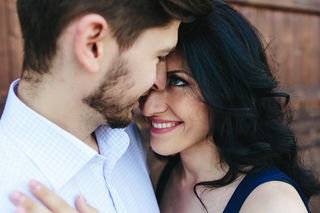Mating
3 Central Elements of Romantic Attraction
...and how to develop each to land the kind of relationship you're looking for.
Posted June 21, 2016 Reviewed by Jessica Schrader
Key points
- Usually, short-term and more exclusively sexual relationships require the most physical attractiveness.
- Psychological attractiveness is displayed through a pleasant and cheerful personality, which seems to bring the best out in others and oneself.
- Behavioral attractiveness is attractiveness is what people are generally referring to when they say confidence can be sexy.

When we think about dating and relating to a partner, being attractive and sexy often comes to mind. That feeling of attraction is the "chemistry" or spark that motivates us to be with another person—and them with us.
But what makes someone attractive? Is it looks, resources, behavior, intelligence, or something more unique and special? With a little effort, we could probably think of someone who is attractive for each of those reasons. We could also find examples of people who are sexy for some other quality altogether. As a result, even if we have a preferred "type," we rarely have a good idea as to what is attractive—and why.
I have given these questions a lot of thought over the years, and written quite a few posts on the topic. Looking back, I see there are actually a few different ways to be attractive and desirable to a partner. However, which way (or ways) each of us decides to be attractive depends on our own traits, and what kind of relationship we're looking for.
Physical Attractiveness: Looking Sexy
We all know that looks are important for attraction. What most people do not realize is that looks are more or less important, depending on the type of relationship you want—and what else you bring to the exchange with your partner. Usually, short-term and more exclusively sexual relationships require the most physical attractiveness, with looks becoming of lesser importance as relationships lean toward intimacy, sharing, and long-term support.
In any case, the physical features that tend to be the most attractive to others are the ones that serve as the best indicators of health and fitness. Because these features can change with our health over time, however, this also means that the most attractive features are those most under our control to manage, too. Things like proper grooming and basic physical fitness, then, may be more important than having the perfect chest or the most symmetrical nose.
For those who do not have the perfect physique, clothing can play a role in physical attraction too. The right outfit can flatter and display our more attractive features, while hiding or downplaying others. The right color outfit, or a pair of sexy shoes, can add to attraction as well. Beyond that, clothing and accessories also send a social message about your (potential) resources. That may not be bad, because people have sex for a number of reasons. Nevertheless, putting too much emphasis on fancy clothing may leave you wondering whether a lover is cozying up to get closer to your body—or your wallet.
Psychological Attractiveness: Creating Connections
On the opposite end of the spectrum are the psychological traits and features that we find attractive. These features are more motivating for longer-term and emotionally intimate connections. Unfortunately, relying on them alone poses some difficulties: Just as relying solely on looks may get you a series of hookups that fizzle out, focusing on personality alone may result in deep friendship connections without a sexual spark (i.e., the "friend zone").
Nevertheless, psychological attractiveness is still an important influence in relationships, especially long-term ones. Usually such attractiveness is displayed through a pleasant and cheerful personality, which seems to bring the best out in others, and in one's self. These attractive individuals often develop a unique style, perspective, and/or skill to share with others that separates them from the crowd.
Most of the time, these traits are conveyed through verbal communication. Therefore, developing psychological attractiveness involves learning the skills to develop rapport with others. This may include having conversations that create a feeling of intimacy and connection, as well as discussing topics that pique sexual and romantic interest. Overall, having something positive and unique to say—and saying it with skill and style—can make you quite attractive in the psychological sense. Just be sure to follow it up with something more than words if you'd like the relationship to be physical, too.
Behavioral Attractiveness: Making Bold Moves
Behavioral attractiveness lies somewhere between the physical and psychological realms. This type of attractiveness is what people are generally referring to when they say that confidence can be sexy. Sometimes people are attractive and desirable simply for the way they act and move. They may have just the right body language to be both aloof and engaging. They might also make the most alluring and exciting eye contact. They know how to smile, flirt, and get noticed with their behavior.
Beyond body language, touch also plays an important role in behavioral attractiveness. In fact, touch is an essential way to communicate and influence without words. When done in the right way, touching can make someone feel more attracted to you. Touch can also increase physical intimacy, which makes passionate kissing (and sexual activity) more likely. Further, touching communicates friendliness and high-status on your part, making a touch more likely to elicit agreement and acceptance.
These behaviors are often a way to display confidence and high status. As such, partners may be attracted to the allure of the behaviors themselves—or they may be interested in the status they think the behaviors indicate. In other words, you may find yourself needing some other trait or feature to back up these bold moves. In combination with a bit of physical attractiveness, such behaviors can really entice a lover. Combined with some psychological attractiveness, the same behaviors can help create a lasting connection.
Finding Your Own Style of Attraction
Making ourselves attractive and selecting an attractive mate requires trade-offs. Each of us is different, and we have only so much opportunity to work on developing attractive traits, in various ways, to ultimately get the kind of relationship we want. On the plus side, that means no one is perfect—so you don't have to be perfect either. Nevertheless, we do have to focus on developing the features that can help us have a satisfying social life.
To increase your chances of getting a satisfying and compatible partner, focus first on your strengths and preferred style(s) of attractiveness. Do what comes best and most naturally to you. After that, work on other skills and traits that may help you establish the kinds of relationships you want. You don't have to master everything, but try your best to improve areas that may impose serious limitations for socializing (e.g., poor hygiene, gloomy personality, extreme shyness, etc.). Then go out and find a partner who will appreciate those qualities and be attracted to what you have to offer.
© 2016 by Jeremy S. Nicholson, M.A., M.S.W., Ph.D. All rights reserved.




